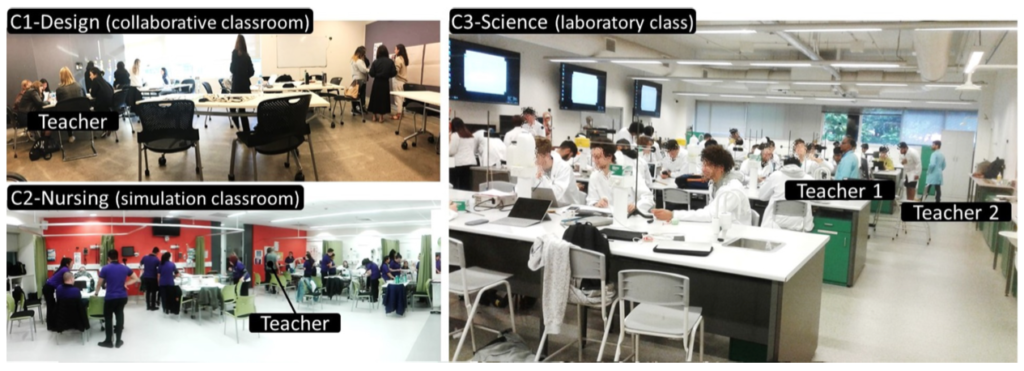Analytics for “classroom proxemics”


In concert with making the best use of online learning at UTS, an enormous amount of learning and teaching still happens face-to-face — except when there’s a global pandemic on! The UTS learning.futures model underpins the massive redesign of our on-campus learning spaces.
The term “Classroom Proxemics” refers to how teachers and students use classroom space, and the impact of this and the spatial design on learning and teaching. While learning analytics is usually thought of in terms of capturing, analysing and feeding back activity that is mediated by a collaborative platform, one can now be teaching and learning face-to-face, whilst also generating digital traces from embodied activity (as well as being online via one or more platforms).
Roberto Martinez-Maldonado (who pioneered our work on multimodal learning analytics to support nursing teams in simulated wards) has developed a new strand of work, on the potential of tracking (with consent of course), how educators make use of learning spaces as they teach. Working closely with academics in the Science and Health Faculties, the results of which are now being published, and demonstrate:
- the process we use to work closely with educators to co-design potentially invasive technologies in ethical ways
- the potential educators see in being able to visualise their teaching practice in this way
- the problems they perceive with such tools if they are used in appropriately
Martinez-Maldonado, R., Schulte, J., Echeverria, V., Gopalan, Y. and Buckingham Shum, S. (2020). Where is the Teacher? Digital Analytics for Classroom Proxemics. Journal of Computer Assisted Learning, to appear (Accepted March. 2020).
The term “Classroom Proxemics” refers to how teachers and students use classroom space, and the impact of this and the spatial design on learning and teaching. This paper addresses the divide between, on the one hand, substantial work on proxemics based on classroom observations and, on the other hand, emerging work to design automated feedback that helps teachers identify salient patterns in their use of the classroom space. This paper documents how digital analytics were designed in service of a senior teacher’s practice-based inquiry into classroom proxemics. Indoor positioning data from four teachers were analysed, visualised and used as evidence to compare three distinct learning designs enacted in a physics classroom. This paper demonstrates how teachers can make effective use of such visualisations, to gain insight into their classroom practice. This is evidenced by i) documenting teachers’ reflections on visualisations of positioning data, both their own and that of peers; and ii) identifying the types of indicator (operationalised as analytical metrics) that foreground the most useful information for teachers to gain insight into their practice.
Martinez-Maldonado, R., Mangaroska, K., Schulte, J., Elliott, D., Axisa, C. and Buckingham Shum, S. (2020). Teacher Tracking with Integrity: What Indoor Positioning Can Tell About Instructional Proxemics. Proceedings of the ACM on Interactive, Mobile, Wearable and Ubiquitous Technologies
(UBICOMP): to appear (Accepted Jan. 2020).
Automatic tracking of activity and location in the classroom is becoming increasingly feasible and inexpensive. However, although there is a growing interest in creating classrooms embedded with tracking capabilities using computer vision and wearables, more work is still needed to understand teachers’ perceived opportunities and concerns about using indoor positioning data to reflect on their practice. This paper presents results from a qualitative study, conducted across three authentic educational settings, investigating the potential of making positioning traces available to teachers. Positioning data from 28 classes taught by 10 university teachers was captured using sensors in three different collaborative classroom spaces in the disciplines of design, health and science. The contributions of this paper to ubiquitous computing are the documented reflections of teachers from different disciplines provoked by visual representations of their classroom positioning data and that of others. These reflections point to: i) the potential benefit of using these digital traces to support teaching; and ii) concerns to be considered in the design of meaningful analytics systems for instructional proxemics.
Martinez-Maldonado, R. R., Elliott, D., Axisa, C., Power, P., Echeverria, E. and Buckingham Shum, S. (2020). Designing translucent learning analytics with teachers: an elicitation process. Interactive Learning Environments: to appear (Accepted: 20 October 2019).
Learning Analytics (LA) systems can offer new insights into learners’ behaviours through analysis of multiple data streams. There remains however a dearth of research about how LA interfaces can enable effective communication of educationally meaningful insights to teachers and learners. This highlights the need for a participatory, horizontal co-design process for LA systems. Inspired by the notion of translucence, this paper presents LAT-EP (Learning Analytics Translucence Elicitation Process), a five-step process to design for the effective use of translucent LA systems. LAT-EP was operationalised in an authentic multimodal learning analytics (MMLA) study in the context of teamwork in clinical simulation. Results of this process are illustrated through a series of visual proxies co-designed with teachers, each presenting traces of social, physical, affective and epistemic evidence captured while teams of student nurses practised clinical skills in a simulated hospital setting.